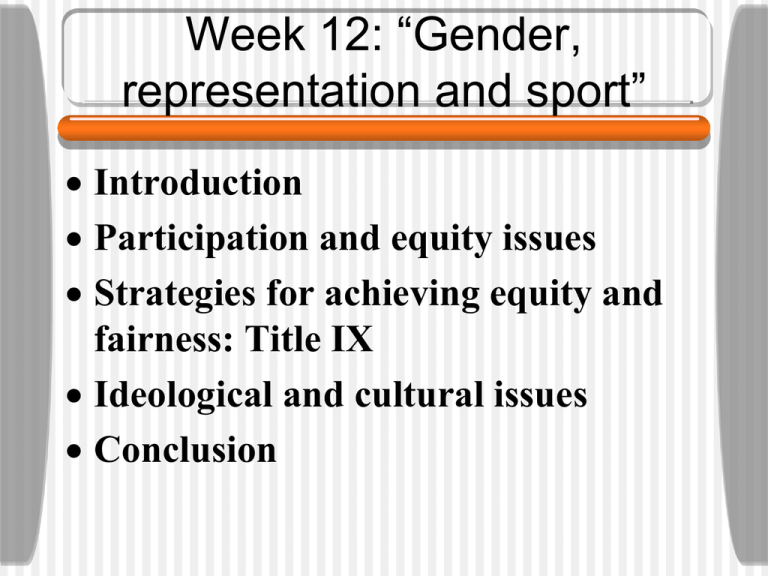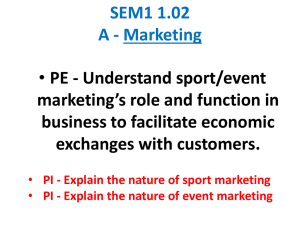
Week 12: “Gender,
representation and sport”
Introduction
Participation and equity issues
Strategies for achieving equity and
fairness: Title IX
Ideological and cultural issues
Conclusion
Introduction
Gender relations in sport focus on two
interrelated areas, namely i) questions of
fairness and equity and ii) those of ideology,
representation and culture.
Questions of fairness and equity deal with:
Introduction
Issues relating to ideological, representation and
cultural issues refer to:
Participation and equity
issues
Reasons for the increased participation
include:
1. new opportunities – prior to the mid-1970s
many girls and women did not play sport for
the simple reason that teams and programs
did not exist.
Participation and equity
issues
1. new opportunities – number of Olympic
events open to men and women
Participation and equity
issues
2. Government and equal rights
legislation - policies to promote equal access
have had major impact
Participation and equity
issues
3. The global women’s rights movement – the
global women’s rights movement over the past 30
years has emphasized that females are enhanced as
human beings when they develop their intellectual
and physical abilities.
Participation and equity
issues
4. The health and fitness movement –
people are more aware now of the health
benefits of physical activities. Sport
companies in particular have been keen to
promote fitness and sports to women and the
image of the “athletic female” as a way to
increase sales
Participation and equity
issues
5. Increased media coverage of women in
sports – increased coverage of women’s
sports has helped to increase awareness and
potentially participation on the part of girls.
Despite some mixed messages the coverage
of women in sports helps to promote the idea
that sports are human activities rather than
solely male activities
Participation and equity
issues
Reasons to be cautious about future participatory
trends
1. Budget cutbacks and the privatization of
sport programs – sports programs for girls and
women are more vulnerable to cuts because they
are less well established, have less community
support and often have less revenue generating
potential – “it seems like the only time womens
programs are treated equally is when cuts must be
made”
Participation and equity
issues
2. Resistance to government regulations - those who
benefit from the status quo often have a vested interest in
preventing change.
Participation and equity
issues
3. Backlash among those who resent changes
favoring strong women – strong women challenge
the prevailing gender ideology thus such women and
the claims they make are seen as a threat to
entrenched male interests. Many golf clubs for
example have been slow to accept women golfers on
an equal basis.
•Soccer problem: the women assistant ref was attacked b/c
the coach thought she didn’t give them a call
So then he goes off on a tirade saying women have no place and he
stands behind his sexism
Participation and equity
issues
4. Under-representation of women in decision-making
positions in sports – following Title IX there was an
actual decline in the number and proportion of women
head coaches and administrators (soccer being the sole
exception).
Participation and equity
issues
5. Continued emphasis on “cosmetic fitness” –
confusing messages put off young girls concerned with
trying to be firm but shapely, strong and feminine, sporty
and sexy – “get strong but lose weight”
Participation and equity
issues
6. Trivialization of women’s sports – women’s sports,
especially those that emphasize balance, grace and coordination are accorded a secondary status
Women sports are not taken seriously and of those that are, they are more
graceful sports. This awards a second class status
7. Homophobia and the threat of being labeled
“lesbian” – parents may discourage their daughters from
certain sports for fear of them “becoming lesbian”
On bend it like beckham the mother is worried that the daughter is gay b/c she is
so close with her teammates
Strategies for achieving
equity and fairness: Title IX
•
•
•
Prevents gender discrimination in schools that
receive funds from the federal government
1972 Nixon amended the 1964 Civil Rights Act
in order to prevent gender discrimination in
education - the Education Amendments was
passed by Congress
In the mid 1980’s Reagan tried to prevent title 9
from applying to sports but was passed with the
Civil Rights Restoration Act in 1987.
Strategies for achieving
equity and fairness: Title IX
•The U.S. Department of Education’s Office of Civil Rights developed a
clarification of Title IX’s impact for sport. A school is in compliance if it
meets any one of these tests:
1.Proportionality test: womens sports participation must be porportional
to the number of full time female students
2.History of progress test: school must have a clear history and
continuing practice of expanding its sports programs for female athletes
3.Accommodation of interest: school must demonstrate that its sports
program fully accommodates the interests of female students
•Between 1971 and 2002 the number of girls playing high school varsity
sports increased from 295,000 to about 2.8 million; instead of 1 out of
every 27 playing on teams it is now 1 in 3; the numbers of female
intercollegiate teams has increased from 32,000 to about 160,000
Ideological and cultural
issues
Historical constructions of gender ideology:
patriarchal views about women as the “weaker sex”
were challenged by women’s engagement with sporting
activities and leisure pursuits such as cycling.
Victorian moralists worried that female cyclists would
make them unfeminine who lacked the physical
abilities to ride bikes fast and that unchaperoned
women would not be trusted around men.
Ideological and cultural
issues
Historical constructions of gender ideology: Of
course, the reality was that there was no scientific basis
for such claims. Instead the views of scientists and
moralists were actually concerns about the new found
freedom that women were enjoying – the restrictions
that men tried to impose stemmed from control issues
in nature
•As Holt notes “Personal transport meant private
mobility and the prospect of freedom from surveillance,
the right to go out and explore the world, to be in
charge of one’s own destiny.” (Holt, 1990, p. 122, Sport
Ideological and cultural
issues
Contemporary constructions of gender ideology:
• the ideological construction of the “fragile female”
body discourse continues today.
• female athletes are subject to a sexualized discourse
whereby such athletes are required by sponsors and
associations to look attractive, emphasize their
(hetero)sexuality, and are often photographed in softcore pornographic ways.
• rather than seeing female athletes as active performers
such representational techniques reduce women to
submissive sex objects.
Ideological and cultural issues
Apart from marginalizing the sporting
achievements of female athletes the results of
these types of sexualized images and the
emphasis on “cosmetic fitness” can have very
damaging effects on girls’ and women’s selfperceptions.
Ideological and cultural issues
•Such messages can even have an effect on motor
performance in sport
•As Coakley (2007, p. 247) notes, even as infants, females are
handled more gently than boys, boys are encouraged to be
more physically active and to use their bodies whilst girls are
more closely watched – this affects the motor development of
boys and girls
•Baby X studies: exactly the same baby was shown to people
and told that it was either a female or male.
Female was described as ‘fragile, soft, and gentle’ and the male was
given balls to play with and described as ‘masculine with a strong
grip’
Ideological and cultural issues
•When combined with how girls are conditioned to
see their bodies though the eyes of others this can
have material effects on sports performance
•A recent study (Fredrickson and Harrison’s “Throwing like a Girl:
Self-objectification predicts adolescent girls” motor performance’, in
showed that adolescent
girls tend to self -objectify at higher rates than boys
– that is, having a third-person perspective on their
own bodies
Journal of Sport and Social Issues, 2005)
Ideological and cultural issues
•Self-objectification has a number of consequences
including an increased form of self-consciousness
characterized by vigilant monitoring of the body’s
outward appearance which can lead to eating
disorders, anxiety, body shame and even depression
•Fredrickson and Harrison’s (2005) study shows that
there are also physical as well as emotional
consequences of women’s self-objectification
Ideological and cultural issues
•Fredrickson and Harrison (2005) conclude
that “according to this analysis ‘throwing like
a girl’ and otherwise failing to make use of
one’s body’s spatiality and physical potential
reflects girls’ and women’s deep
internalization of objectifying cultural
attitudes toward the female body”
Ideological and cultural
issues
Gay and lesbian sporting identities
• Gender ideology is based on a binary classification system
in which all people are classified as being either male or
female (sex) and then expected to have either a masculine
or feminine (gender) identity
• This fixed binary system does not match the actual
complex diversity of the human spectrum
• Those who are born with physical traits that do not “fit”
within this system are surgically “corrected” and we go to
great lengths to artificially create and enhance “natural”
gendered distinctions – plastic surgery is often about
enhancing sexualized notions of gender difference
Ideological and cultural
issues
• Lesbian athletes often have to hide their identities
• Paradoxically, the pressures on gay men are often
greater
• Women have less to lose and more to gain if they
push boundaries; men have less social permission
to express the feelings, attitudes, and actions
associated with femininity
Ideological and cultural
issues
• Latent homo-eroticism in men’s sports?
• Men’s sports provide an arena for physical
touching, caressing, hugs and kisses. Acts of
homosocial intimacy that would normally be
forbidden in most other heteronormative arenas –
sports might be seen as a ritualistic space for the
enactment of male-on-male desire
Celebrating and redefining masculinities
•Sports are a domain for the
exhibition of hegemonic
masculinity
•The masculinized culture
of sport is often transposed
into politics when
politicians try to appear
“tough”, “macho” and
“hard” in order to dominate
others and convince the
electorate of their “strength”
Celebrating and redefining masculinities
•The effects of this can often be
damaging to men too – having to
“take it like a man” and avoid
being seen as “weak” prevents
men from admitting to
uncertainty.
•When transposed to the political
arena, this uncertainty can often
prove disastrous when politicians
refuse to reverse a policy for fear
of being called “weak” or
indecisive
Female body builders: challenging
gender codes?
•Many see female body
builders as deviant and
“unnatural” because they
visibly transgress the socially
acceptable lines of gender
distinctions
•Female body builders are no
more or less “unnatural” than
male bodybuilders – it is our
reaction to such images that
reveals a certain disdain for
strong, powerful women
Conclusion
• Gender ideology continues to influence sport in profound
ways – how sports are structured; how we view sports,
who gets selected to play and hired to coach, and how we
understand gender relations more widely
• Challenging gender ideology is difficult as i) it is an area
where socially constructed differences are naturalized and
appear uncontentious and ii) those who benefit from the
current arrangements in sport may be unwillingly to give
up their privileged position.
Conclusion
• The trend towards greater opportunity in
sport is not a natural process and is
dependent upon continued pressure to make
sport more equitable.
• “opportunities for women on the
professional level will continue to be
limited until ideas and beliefs about
femininity expand to embrace multiple
notions of womanhood.








